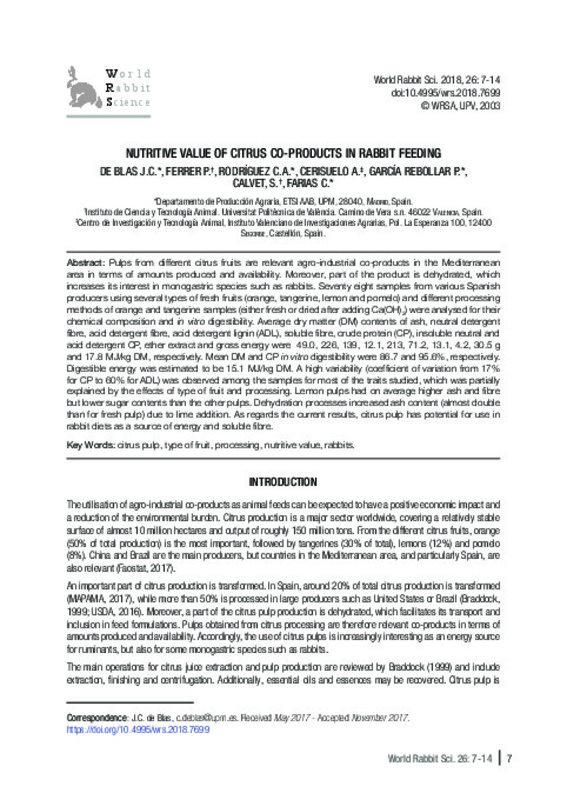JavaScript is disabled for your browser. Some features of this site may not work without it.
Buscar en RiuNet
Listar
Mi cuenta
Estadísticas
Ayuda RiuNet
Admin. UPV
Nutritive value of citrus co-products in rabbit feeding
Mostrar el registro sencillo del ítem
Ficheros en el ítem
| dc.contributor.author | de Blas, J. Carlos
|
es_ES |
| dc.contributor.author | Ferrer, Pablo
|
es_ES |
| dc.contributor.author | Rodríguez, Carlos Alberto
|
es_ES |
| dc.contributor.author | Cerisuelo, Alba
|
es_ES |
| dc.contributor.author | García-Rebollar, Paloma
|
es_ES |
| dc.contributor.author | Calvet, Salvador
|
es_ES |
| dc.contributor.author | Farias, Carlos
|
es_ES |
| dc.date.accessioned | 2018-04-10T07:34:34Z | |
| dc.date.available | 2018-04-10T07:34:34Z | |
| dc.date.issued | 2018-03-28 | |
| dc.identifier.issn | 1257-5011 | |
| dc.identifier.uri | http://hdl.handle.net/10251/100094 | |
| dc.description.abstract | [EN] Pulps from different citrus fruits are relevant agro-industrial co-products in the Mediterranean area in terms of amounts produced and availability. Moreover, part of the product is dehydrated, which increases its interest in monogastric species such as rabbits. Seventy eight samples from various Spanish producers using several types of fresh fruits (orange, tangerine, lemon and pomelo) and different processing methods of orange and tangerine samples (either fresh or dried after adding Ca(OH)2) were analysed for their chemical composition and in vitro digestibility. Average dry matter (DM) contents of ash, neutral detergent fibre, acid detergent fibre, acid detergent lignin (ADL), soluble fibre, crude protein (CP), insoluble neutral and acid detergent CP, ether extract and gross energy were 49.0, 226, 139, 12.1, 213, 71.2, 13.1, 4.2, 30.5 g and 17.8 MJ/kg DM, respectively. Mean DM and CP in vitro digestibility were 86.7 and 95.6%, respectively. Digestible energy was estimated to be 15.1 MJ/kg DM. A high variability (coefficient of variation from 17% for CP to 60% for ADL) was observed among the samples for most of the traits studied, which was partially explained by the effects of type of fruit and processing. Lemon pulps had on average higher ash and fibre but lower sugar contents than the other pulps. Dehydration processes increased ash content (almost double than for fresh pulp) due to lime addition. As regards the current results, citrus pulp has potential for use in rabbit diets as a source of energy and soluble fibre. | es_ES |
| dc.description.sponsorship | This project was funded by the Spanish Ministry of Science and Innovation (AGL2014-56653). Authors are grateful to FEDNA for the grant obtained by Mr. Farias. | es_ES |
| dc.language | Inglés | es_ES |
| dc.publisher | Universitat Politècnica de València | |
| dc.relation.ispartof | World Rabbit Science | |
| dc.rights | Reserva de todos los derechos | es_ES |
| dc.subject | Citrus pulp | es_ES |
| dc.subject | Type of fruit | es_ES |
| dc.subject | Processing | es_ES |
| dc.subject | Nutritive value | es_ES |
| dc.subject | Rabbits | es_ES |
| dc.title | Nutritive value of citrus co-products in rabbit feeding | es_ES |
| dc.type | Artículo | es_ES |
| dc.date.updated | 2018-04-10T07:00:57Z | |
| dc.identifier.doi | 10.4995/wrs.2018.7699 | |
| dc.relation.projectID | info:eu-repo/grantAgreement/MINECO//AGL2014-56653-C3-2-R/ES/EFECTO DE LA INCLUSION DE SUBPRODUCTOS EN LAS EMISIONES DE GASES DE LOS PURINES. EVALUACION GLOBAL DE LOS IMPACTOS AMBIENTALES/ | |
| dc.rights.accessRights | Abierto | es_ES |
| dc.description.bibliographicCitation | De Blas, JC.; Ferrer, P.; Rodríguez, CA.; Cerisuelo, A.; García-Rebollar, P.; Calvet, S.; Farias, C. (2018). Nutritive value of citrus co-products in rabbit feeding. World Rabbit Science. 26(1):7-14. https://doi.org/10.4995/wrs.2018.7699 | es_ES |
| dc.description.accrualMethod | SWORD | es_ES |
| dc.relation.publisherversion | https://doi.org/10.4995/wrs.2018.7699 | es_ES |
| dc.description.upvformatpinicio | 7 | es_ES |
| dc.description.upvformatpfin | 14 | es_ES |
| dc.type.version | info:eu-repo/semantics/publishedVersion | es_ES |
| dc.description.volume | 26 | |
| dc.description.issue | 1 | |
| dc.identifier.eissn | 1989-8886 | |
| dc.contributor.funder | Ministerio de Economía y Competitividad | |
| dc.contributor.funder | Fundación Española para el Desarrollo de la Nutrición Animal |








